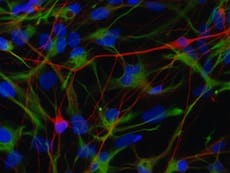Finding ALS Treatments That Work For All Patients
NewsThe Context: ALS is a disease that manifests differently in each patient, with some cases resulting from genetic predispositions, and others sporadically. Because the causes can vary so widely, it is difficult to find medications that will work for most or all patients.
The Study: In two new studies, scientists led by NYSCF – Robertson Stem Cell Investigator Alumnus Justin Ichida, PhD of the University of Southern California have discovered new opportunities for treating ALS that could provide improvement for large groups of patients. In the first study, published in Cell Stem Cell, the team found that suppressing activity of a gene called TDP-43 could help reduce overactivity in motor neurons (a hallmark of ALS). In the second study, published in Cell, the researchers found inhibiting a different protein called PIKFYVE could also help reduce symptoms by helping motor neurons clear out waste from their surroundings.
The Importance: These studies define promising new therapeutic targets for ALS, opening the door for treatments that could work for many different patients with different forms of ALS.
Suppressing a Gene to Calm Overactive Brain Cells
In their first study, published in Cell Stem Cell, the scientists started by creating stem cells from patients with both familial (inherited/genetic) ALS and sporadic ALS, and converted them into motor neurons, the cells primarily affected by the disease. These cells serve as key testing material for potential drugs, as they carry the disease features (including genetics) of the patient donors.
Dr. Ichida and colleagues tested numerous potential drugs and found that the most effective ones happened to increase the activity of sex hormones called androgens. Unfortunately, increased androgen activity can have unsafe side effects for ALS patients, leaving Dr. Ichida’s team wondering if they could achieve the same result in another way.

They turned to a bioinformatics database called ‘Connectivity Map’ – developed at the Broad Institute of MIT and Harvard – that aggregates information about how drugs interact with genetics. Based on information from this database, the team predicted that suppressing activity of a certain gene called SYF2 could act as an effective dupe for the androgen-increasing drugs. Suppressing SYF2 increased the survival of patient-derived motor neurons, and in mouse models, it reduced neurodegeneration and other symptoms.
What’s most promising about the finding is its potential to treat many different forms of ALS.
“What’s really exciting is that SYF2 suppression improved symptoms and pathology related to a protein called TDP-43, which can become toxic and is implicated in close to 97 percent of cases of ALS,” said Yichen Li, PhD, a postdoc in the Ichida Lab, in an article from USC.
Helping Motor Neurons Clean Up
In their second study, published in Cell, the team turned their attention to inhibiting a certain protein called the PIKFYVE kinase, finding that this approach could help clear out proteins that are prone to aggregation in ALS patient neurons.
The researchers used a drug to inhibit PIKFYVE in cells derived from ALS patients, as well as in a host of other model organisms, including fruit flies, roundworms, and mice. As they suspected, suppressing PIKFYVE reduced neurodegeneration, improved motor function, and prolonged life by prompting motor neurons to clear out toxic proteins that can build up in cells.
“We were able to pinpoint precisely how PIKFYVE inhibition mitigates neurodegeneration, which is important for informing the development of new targeted treatments,” said Shu-Ting (Michelle) Hung, a PhD student in the Ichida Lab.
“Our discoveries bring us closer to achieving our big picture goal: finding treatments that can be broadly effective for all patients who suffer from ALS,” added Dr. Ichida.
Journal Articles:
PIKFYVE inhibition mitigates disease in models of diverse forms of ALS
Shu-Ting Hung, Gabriel R. Linares, Wen-Hsuan Chang, Yunsun Eoh, Gopinath Krishnan, Stacee Mendonca, Sarah Hong, Yingxiao Shi, Manuel Santana, Chuol Kueth, Samantha Macklin-Isquierdo, Sarah Perry, Sarah Duhaime, Claudia Maios, Jonathan Chang, Joscany Perez, Alexander Couto, Jesse Lai, Yichen Li, Samuel V. Alworth, Eric Hendricks, Yaoming Wang, Berislav V. Zlokovic, Dion K. Dickman, J. Alex Parker, Daniela C. Zarnescu, Fen-Biao Gao, Justin K. Ichida. Cell. 2023. DOI: https://doi.org/10.1016/j.cell.2023.01.005
SYF2 suppression mitigates neurodegeneration in models of diverse forms of ALS
Gabriel R. Linares, Yichen Li, Wen-Hsuan Chang, Jasper Rubin-Sigler, Stacee Mendonca, Sarah Hong, Yunsun Eoh, Wenxuan Guo, Yi-Hsuan Huang, Jonathan Chang, Sharon Tu, Nomongo Dorjsuren, Manuel Santana, Shu-Ting Hung, Johnny Yu, Joscany Perez, Michael Chickering, Tze-Yuan Cheng, Chi-Chou Huang, Shih-Jong James Lee, Hao-Jen Deng, Kieu-Tram Bach, Kamden Gray, Vishvak Subramanyam, Jeffrey Rosenfeld, Samuel V. Alworth, Hani Goodarzi, Justin K. Ichida. Cell Stem Cell. 2023. DOI: https://doi.org/10.1016/j.stem.2023.01.005
Cover photo by Damon Casarez, USC

